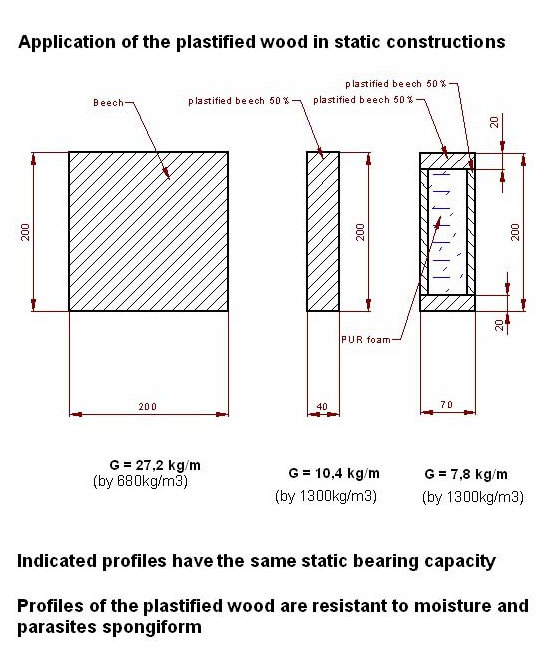Wood plastification - Further exploitation
The plastified wood offers many other possibilities for its application. I will present some of them:
1. Load-bearing static elements in the process of wood structures manufacturing
2. Veneers manufacturing
3. Garden furniture manufacturing
4. Windows manufacturing
5. Load-bearing elements for vessels and luxury yachts sheathing
LOAD-BEARING STATIC ELEMENTS IN THE PROCESS OF WOOD STRUCTURES MONUFACTURING

By the means of plastification the significant change in mechanic properties occurs. It is very important from the viewpoint of the load capacity of the static element. When the beech wood is plastified to the level of ebony the change in beam strength from 105 MPa (of non-plastified wood) to 550 MPa occurs.
Hereafter, I will illustrate different wooden beams at the same bending properties.
From the pictures, we can clearly see it is possible to reduce the weights of statically stressed wood structures elements even by 70%.
The resistance to fungous parasites and humidity is a property that is even more important. The applications for structures such as swimming pool halls are possible.
The application of the plastified wood in the load-bearing elements of the static constructions represents minimizing the demands on the maintenance, thus on the operational costs.
This area seems to be the most prospective for the plastified wood utilisation.
The properties of the plastified wood mentioned, have not been used so far, but the presented analyses show the real possibilities for its application.
VENEERS MANUFACTURING
The veneers manufacturing from the plastified wood from the semi-operation in Daleke Dušníky have not been realised so far. The attempts to do that have not been successful. The designs of technologies for the veneers manufacturing are prepared based on the tests results. These technologies will be tested and protected by the patents after the commencement of the plant for plastified wood manufacturing. The veneers production itself opens a new and wide area for plastified wood utilisation.The abrasive resistance of the plastified wood is 5 to 6 fold higher than the abrasive resistance of non-plastified wood. It offers many possibilities in the area of floor manufacturing with the plastified wood application.
The utilisation of the veneers offers other possibilities in the area of new technologies for the veneer applications.
GARDEN FURNITURE MANUFACTURING
Garden furniture is made of stained wood or of teak wood.The plastified wood application in the process of garden furniture manufacturing offers many possibilities.
According to the level of transformation, we can get different colour shades. Different colours depend on the type of the plastified wood. From the point of view of possible designer solutions, there exists a wide scale of applications.
A simple maintenance of such furniture is an important characteristic of the plastified wood. If we rub over the furniture with the cloth soaked with cooking oil, the original colour of the plastified wood will be renewed very quickly.
WINDOWS MANUFACTRING
Plastic windows manufacturing is retreating and is being replaced by wooden windows. The manufacturing by itself brings many problems. In order to reduce deformations the glued profiles are used. It is necessary to impregnate wood. In order to prevent the windows to be hit by the fungous parasites, some of their parts, e.g. the corners, are impregnated twice to three times. The outer surface of the windows frames is stained and coated. If the windows face south, it is necessary to renew the coating regularly. The coating renewal costs are about 30% of the price of a new window.The plastified wood enables to eliminate the entire mentioned shortcomings.
The dimensional stability regardless the weather conditions is a significant characteristic of such windows. (Test window has not changed its dimensions for 20 years)
Coating consists of using the oil and wax for impregnation. Consequently, every 3 years a simple maintenance consisting of rubbing the surface with the oil or wax hot-flue is carried out. The life cycle of the window is 50 years minimum.
It is possible to use the hollow sections foamed up with the polyurethane. This method will significantly improve the thermal properties of the window.
In order to reduce the weight, we can use a different kind of wood, e.g. poplar. The colour of the wood after plastification is „meranti“
LOAD-BEARING ELEMENTS FOR VESSELS AND LUXURY YACHTS SHEATHING
The significant improvement of the plastified wood properties predetermines it as one of the best materials for load-bearing elements of the vessels.Apart from the reduced weight, it is resistant against humidity, salt water and parasites that degrade wood.
The colour properties of the plastified wood and its resistance against the salt water and different weather conditions create the excellent conditions for vessels sheathing and luxury yachts sheathing.
Specimen tube
Proposal